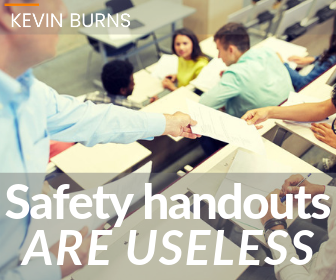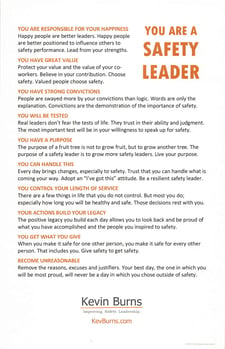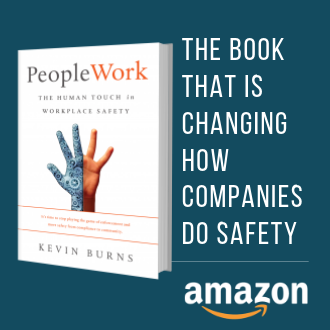Safety Handouts Are Useless
 Have you ever cleaned out an old box of papers only to discover some old seminar handouts? Maybe one of those cheesy fill-in-the-blanks workbooks or a stack of Powerpoint slide printouts? You can see your own handwritten words in the blanks, but you can’t recall the session nor much of the information. Funny how the meetings or seminars you attend where you take your own notes, you recall much more of the session.
Have you ever cleaned out an old box of papers only to discover some old seminar handouts? Maybe one of those cheesy fill-in-the-blanks workbooks or a stack of Powerpoint slide printouts? You can see your own handwritten words in the blanks, but you can’t recall the session nor much of the information. Funny how the meetings or seminars you attend where you take your own notes, you recall much more of the session.
Handouts are useless. Qualify that: bad handouts are useless. Especially the fill-in-the-blank handouts. It’s paint-by-numbers for adults. You fill in the blanks as the seminar leader tells you to. You close the handout workbook at the end. You file it in a drawer or a box. The next time you see it, you’ll be cleaning out your desk at retirement.
 Now, as a point of note, I do actually use one handout - but only for my one-hour keynote presentations. And I've been doing it for twenty years. The ten points in the keynote are written on one side of a single large poster-style postcard. These handouts have value even if you have never attended the session. In fact, some of my old handouts still hang in offices years later. Want to see it? Get a copy of "You Are A Safety Leader" handout here.
Now, as a point of note, I do actually use one handout - but only for my one-hour keynote presentations. And I've been doing it for twenty years. The ten points in the keynote are written on one side of a single large poster-style postcard. These handouts have value even if you have never attended the session. In fact, some of my old handouts still hang in offices years later. Want to see it? Get a copy of "You Are A Safety Leader" handout here.
Now, unless your handouts can be posted in a single document the size of a book cover and can be relevant for years, then you may need to re-think your handouts.
You’re doing too much.
If you’re trying to get your people to connect more with and participate in the safety program, here’s why handouts are useless. Because meeting attendees don’t do any work. The meeting leader does everything and leaves a few spaces for attendees to write what the leader tells you to write. The work is done for them. They don’t have to invest in what they’re doing.
But, isn’t the point of safety meetings to try to get people to invest themselves in safety?
- Do your people carry pen and paper into safety meetings?
- Do you hand out a summary or a takeaway from your safety meetings?
- Do you actively encourage your people to take notes in meetings or write down observations when they are in the field?
- Are you doing too much of the work?
I have attended over a thousand safety meetings in over 20 years and I have seen only one meeting where people brought their own writing materials into the meeting. One meeting in a thousand. That speaks volumes.
(Watch "The Effective Safety Committee Mindset" video above for an example of how notepads can be used effectively by front-line employees – especially those on the safety committee.)
The problem is that no one follows-up on the information discussed at the meeting. When students in a high-school class are told that something will be on the test, they write it down, study it and remember it. Use this same idea to improve recall and participation in safety meetings.
Go from handout to hand-up.
Instead of offering a handout, consider offering a hand-up. Start thinking differently about how you run your safety meetings. Ask your people to recall the information presented at safety meetings.

Tell your people at the end of a safety meeting that at the (pick a day) morning tailgate or toolbox meeting, there is going to be discussion on today's safety briefing. Tell them they will be asked to add to the discussion. Tell them there will be a test. Tell them what’s on the test. They’ll be ready? They'll take notes. (And then don't forget to do it at the tailgate or toolbox - that's the most important part.)
Ask them to act like the professionals they are. Don’t consider scraps of used photocopy paper and pencils on the table to be how professionals take notes. No phone note-taking either. No phones in the meeting. Make them write it down. If they want to put into their phone after the meeting, fine.
If you want to be more effective with your meetings, to engage employees in safety, ask them to take part. Don’t do the work for them. Make them work for themselves. Reduce the amount of safety meeting information you throw at them and give them more time to be allowed to take notes, to write down their thoughts and ideas. Change how you do safety meetings. Out with Powerpoint lectures and move to an interactive session where they can ask questions, get clarity and write it down.
How you get it started.
Consider purchasing a good quality notepad for each of your people. Put your logo on the front with “Safety Notes” embossed on the cover. Or, offer your people an allowance of $10 per person to go buy one of their own – something that feels comfortable for them. Ensure that every employee has note-taking materials at the start of every safety meeting or briefing. Remind them that what they learn today will come up again at a future tailgate or toolbox.
Change the standard. Raise the level of expectation. Give them a hand-up. Not a handout.
--
Kevin Burns, consultant/author, works with smart, caring companies to energize safety culture, build teamwork, and get employee buy-in. Kevin is on a mission to help employees purposefully care about the work they do and to actively look out for the people they do it with. http://www.kevburns.com


